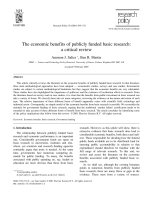THE ECONOMIC BENEFITS OF IMPROVING LITERACY SKILLS IN THE WORKPLACE pdf
Bạn đang xem bản rút gọn của tài liệu. Xem và tải ngay bản đầy đủ của tài liệu tại đây (238.81 KB, 15 trang )
CONFERENCE BRIEFING
THE ECONOMIC BENEFITS OF
IMPROVING LITERACY SKILLS IN
THE WORKPLACE
BY MICHAEL R. BLOOM, MARIE BURROWS, BRENDA
LAFLEUR AND ROBERT SQUIRES
There are clear
economic benefits
in improving
workplace literacy,
but the message
has not yet
reached many
Canadian
workplaces.
Benefits of literacy
training cited by
employers were the
improved learning
facility of the
employees, their
ability to work
together as a team,
and improved
labour-
management
relations.
Enhancing literacy levels in the workplace improves
bottom- line performance for Canada's employers and
gives employer's a better chance for success in their
careers. The results of the Conference Board's study, The
Economic Benefits of Improving Literacy Skills in the
Workplace, demonstrate that there are clear economic
benefits for both employers and employees in improving
workplace literacy. The findings contained in this
Conference Briefing and in the forthcoming research
report, to be released in summer 1997, show that
employers enhance the performance of their businesses in a
wide variety of ways that strengthen the bottom line, and
employees are better able to succeed in the workplace
when their literacy skills improve.
These findings are significant for both business and
individuals. In the past, choices about investing in literacy
were often made without having the right information to
make the best- informed decision. Today, however, there is
growing recognition that literacy is such a critical factor in
corporate and personal success that it demands greater
consideration and understanding. Employers are beginning
to pay more attention to the potential impact of literacy on
their business success, and employees are asking
themselves to what extent literacy skill levels affect their
own personal success and economic wellbeing. This study
clearly shows that they should be even more attentive to
the literacy issue than they are today.
Employees with
higher literacy
skills earn more
income, are less
likely to be
unemployed, have
greater
opportunities for
job mobility, are
more likely
tofindfull- time
work, and are
more likely to
receive further
training.
A male with higher
literacy skills
makes an extra
$585,000 over his
lifetime. For
females, the
amount is
$683,000.
Literacy is important because it affects our human resource
capability. A nation's human resource capability is the key
to future competitiveness in an age when barriers to trade
are disappearing, capital can be moved quickly, and natural
resources are comparatively lowly valued. As a major
trading nation, Canada's companies face significant
competition in the marketplace. Globalization means that
companies are increasingly faced with stiff international
competition at home and abroad. Canada has traditionally
enjoyed a comparative advantage in workforce skins over
many of its competitors. However, recent rapid advances in
the literacy skins of employees in other countries threaten
our advantage; the competitiveness and profitability of our
businesses are at risk. At the same time, the growing
complexity of jobs in Canadian workplaces heightens the
demands being placed on Canadian workers. For many, the
literacy skins that earlier enabled them to do their jobs
effectively are no longer sufficient for them to perform
adequately today. Workers need to continuously acquire
new skins and qualifications to succeed in modern
workplaces.
Traditional Emphasis Is Shifting
Recognition by business and government of the crucial
importance of developing human resources is relatively
new.
Only recently have they become more aware that the economic well-being of Canada
depends crucially on its capacity to make the most effective use of people and to
maintain the skills of its workforce.
Traditionally, business and government focused on finding ways to boost economic
growth by increasing consumer spending, creating a climate that encourages business
investment, and improving Canada's export position. While human resources have
always been considered important to economic performance, they usually took a back
seat to these demand issues.
Today, both business and government are shifting their emphasis. One reason for this
shift is what has been termed by economists as "the productivity paradox." Despite
record investment in machinery and equipment, particularly high-tech, the productivity
record has been disappointing and Canada's economic performance remains below
potential. Unemployment is high, the outlook for youth is discouraging, and the country's
relative position in the global economy has fallen.
1
After a decade of study, evidence is
beginning to emerge that places part of the responsibility on the shoulders of inadequate
employee skills and training. No matter how much capital investment occurs, without
adequate training and education employers and their employees will remain unable to
harvest the full potential of that investment. In other words, more highly skilled, literate
people are key to increasing productivity.
This study explores the economic benefits of improving literacy skills in the workplace,
from the perspective of both employers and employees. The Conference Board identified
and measured these benefits by conducting a survey of employers as well as by analysing
the data gathered on individuals in the 1994 International Adult Literacy Survey (IALS).
Employers Benefit from Enhanced Literacy Skills
Companies offer literacy skills training to their employees because enhanced reading,
writing and numeracy skills will ultimately contribute to a stronger bottom line through
time savings, lower costs, and improvements in the quality of work. The Conference
Board, in a recent survey of 41 companies that offer literacy skills training to their
employees, found that these direct benefits are just the tip of the iceberg as to how
companies benefit from enhancing the literacy skills of their workforce. Other benefits
include unleashing the potential of individual employees, cementing stronger labour-
management relations, and moving the entire organization towards corporate goals set to
ensure success in a highly competitive, often changing marketplace. All of these benefits
from literacy skills training contribute to the company's bottom-line performance.
Tracking the effects of employee training on an organization's operations is very difficult
and, as many respondents noted, prohibitively expensive. For these reasons, few
companies collect quantitative data on the benefits arising from the full range of training
that they deliver to their employees, including literacy skills training. This means that it
is not currently possible to derive an aggregated number that conveys the dollar value to
Canadian employers of improving their employees' literacy skills. Nevertheless, 21
companies that took part in the survey provided qualitative feedback on the benefits of
literacy training, and discussed the impact on their organizations.
1 The Conference Board of Canada, Performance and Potential: Assessing Canada's Social and Economic
Performance (Ottawa: The Conference Board of Canada, 1996), p. 3.
Acknowledgment
This study made possible through funding by the National Literacy Secretariat, Human Resources
Development Canada.
The Conference Board survey cited a list of benefits arising from enhanced literacy skills
as suggested by human capital theory and by previous studies. Table 1 contains, in
descending order according to the number of times cited, the benefits observed by
businesses arising from literacy training. The most widely observed benefits consisted of
the improved learning facility of the employees, the ability of employees to work together
as a team, and improved labour-management relations. Also widely observed were many
line and production benefits such as quality improvements, increased output and reduced
time per task.
At the very core of these benefits is the significant impact that literacy training has on the
self-esteem and self-confidence of the participating individuals. Employers noted that
workers suffering from literacy deficits are very conscious of this fact and often try to hide
this skill deficit from their co-workers. Their employees recognize that this skill deficit has
cut them off from many opportunities to
Exhibit 1
What Is Literacy?
The concept and definition of literacy have changed considerably over the past 20 years. This is
significant because it shapes the way that we use information about literacy to develop policies
and practices. More complex definitions and concepts that have been recently developed
facilitate more sophisticated assessments and evaluations of the impact of enhanced literacy
skills on economic well- being. They also support the introduction of increasingly sophisticated
and effective interventions to bring about improvements in literacy in the workplace.
Early work in the literacy field defined literacy as a condition that adults either have or do not
have. The problems with this approach are that it fails to take into account the multifaceted
nature of literacy; it ignores the reality that skills are a moving target because of the changing
nature of the skills required to function effectively in the labour market; and it ignores the fact
that literacy is about lifelong learning and that literacy skills are maintained and strengthened
through regular use.
By comparison, the International Adult Literacy Survey (IALS), a seven-country comparative
study of adult literacy, incorporates the most sophisticated definition of literacy developed to
date. IALS promotes the definition of literacy as a skill-based proficiency continuum - that is,
literacy is a relative rather than an absolute concept. IALS defines literacy as: "Using printed and
written information to function in society, to achieve one's goals, and to develop one's
knowledge and potential."'
Because literacy cannot be narrowed down to a single skill able to deal with all sods of text, nor
can it be defined as an infinite set of skills able to address every type of text, IALS defines three
distinct literacy types - prose literacy, document literacy and quantitative literacy - and five
levels of literacy within each type.
Prose Literacy - the knowledge and skills needed to understand and use information from texts
including editorials, news stories, poems and fiction
Document Literacy - the knowledge and skills required to locate and use information contained
in various formats, including job applications, payroll forms, transportation schedules, maps,
tables and graphics Quantitative Literacy - the knowledge and skills required to apply arithmetic
operations, either alone or sequentially, to numbers embedded in printed materials, such as
balancing a cheque book, figuring out a tip, completing an order form or determining the amount
of interest on a loan from an advertisement
The Conference Board employed the IALS definition as the basis for our research and analysis.
As the most sophisticated definition currently available, IALS provides the greatest possible
scope and analytical depth when undertaking assessments and evaluations of the economic
impact of improved literacy skills in this study.
1 Organization for Economic Co-operation and Development and Ministry Of Industry Canada, Literacy,
Economy and Society (Paris/Ottawa, 1995), p.14.
Table 1
Ranking of Benefits to Employers
Benefit
Number of citings
Increased ability to handle training on the job
12
Better team performance
11
Improved labour-management relations
10
Increased quality
10
Improved results in job-specific
training/ quicker training results
9
Reduced time per task
8
Increased output of products and services
8
Reduced error rate
8
Better health and safety record
7
Reduced wastage
6
Increased retention of employees
6
Increased profitability
6
Increased customer retention
6
Reduced absenteeism
5
Success in transferring employees
5
Source: The Conference Board of Canada.
advance. Enhanced literacy training offers them the skills they want and need the most.
Once obtained, ideas are better understood by employees as words and language take on
more meaning. They have greater confidence in their ability to communicate, feel
empowered, take ownership of their responsibilities, become more effective and active
decision makers, and assume a more engaging and participative role within their
organization. From this starting point, many benefits arise from enhanced literacy skills in
the workplace. These benefits are described in point form below.
Increased Ability to Handle Training on the Job and Quicker Training Results
Literacy training employees' ability to work with oral and written material and to
grasp new concepts.
Changing economic environment requires businesses to continually upgrade their
employees' skills. As employees improve their literacy skills, they are more wining
to accept new duties
Literacy training helps to establish a strong learning culture in many businesses.
Better Team Performance
Successful teamwork requires understanding and communication: stronger literacy
skills provide both.
Employees with improved literacy skills learn about and understand areas of the
organization other than their own and are more willing to participate in dialogue.
Collaboration in the learning environment survives the classroom and cements the
value of work-related team concepts
Improved Labour-Management Relations
Companies are often surprised at the extent to which literacy training contributes to
better labour-management relations.
Employees value the courses and view their existence as a positive signal that
management is prepared to invest in them. Enhanced literacy skills support the
objectives of both labour and management. Labour views it as a means to promote
from within and strengthen the job security of its membership; management is eager
to upgrade skills and improve productivity.
The success of the programs demonstrates to all that literacy programs work. As a
result, both labour and management often point to workplace literacy training as an
example of how the two sides can work together.
Increased Quality
Employees with improved self-esteem and greater confidence in their ability to
communicate are more engaged and participative at work and put their knowledge to
better use, to the benefit of the employer.
Employees become more confident communicators who are more likely to speak up and
provide valuable feedback affecting product quality and productivity. Tapping into this
knowledge enables companies to improve the quality of products and services.
Reduced Time per Task
Enhanced literacy skills reduce the time needed to process written information, such as
manuals, and to complete paperwork.
Employees with stronger literacy skills assume ownership, become more active thinkers,
and need less time to complete tasks.
Stronger literacy skills make employees better communicators who can work together
more efficiently to get a job done.
Increased Output of Products and Services
Improved literacy skills increase the amount of goods and services that an employee is
able to produce.
As employees strengthen their literacy skills, they become more confident decision
makers, spend less time depending on their co-workers, and have more time to do their
job and to be creative.
Reduced Error Rate
Employees with higher literacy skills are better listeners, pay greater attention to detail
and are more self-assured.
They are more likely to check details when uncertain, commit fewer errors in paperwork,
and follow instructions better.
The outcome can be significant cost savings for the employer.
Better Health and Safety Record
Employees with higher literacy skills are more likely to understand, accept, and follow
health and safety directives in the workplace.
Their improved ability to process information makes them less resistant to change.
They are better listeners and become easier to train. These employees are more likely to
question new or existing procedures, leading to the development of better health and
safety procedures.
Reduced Wastage
A more literate, informed and engaged workforce has a greater sense of the entire
organization and is more likely to offer cost- saving suggestions.
These employees understand better how their individual actions and choices affect the
bottom line.
Increased Retention of Employees
The establishment of literacy skills training is viewed by employees as a positive sign
that companies value education and a learning culture within the organization. As a
result, employees are less likely to leave.
Literacy skills training is often the first step in an ongoing learning process allowing
employees to achieve personal goals and keep pace with a changing workplace that
increasingly demands literacy skills.
In some cases, formal training leads to recognized certification in skills for which an
employee has several years of on-the-job experience.
The ability to promote from within is important where there is a limited supply of labour.
It can also significantly reduce the costs of hirirg and training new employees.
Increased Profitability
Employees with higher literacy skills are more informed, are better decision
makers, and make better use of their time.
Corporate goals are more clearly understood throughout the organization as well
as the implications for how they carry out their responsibilities.
Higher literacy levels help ensure that the entire organization is moving in the
same direction: this alignment can make an important contribution to increasing
profitability.
Increased Customer Retention
Stronger communication skills help employees identify and meet customer needs
more easily and effectively. The result is satisfied customers who are more likely
to continue their business relationship with the employers.
Courses aimed at improving literacy skills raise the organization's profile in their
communities and demonstrate that they are progressive.
Reduced Absenteeism
Employees with broader perspectives on how their actions affect the bottom line
are less likely to be absent from work.
Success in Transferring Employees
Employees with stronger literacy and communications skills move up the learning
curve in new positions more quickly.
Literacy programs provide a forum where companies are able to identify employee
talents that may be employed more profitably elsewhere in the organization.
Literacy Enhances Employees' Prospects Now and for the Future
Employees gain significant benefits when they improve their literacy skills. The LALS
data reveal that workers with higher literacy skills earn more income, are less likely to be
unemployed, experience greater opportunities for job mobility, are more likely to find
full-time rather than part-time work, and are more likely to receive further training.
Improved Literacy Leads to Higher Earnings
While the effect is not uniform across all skills types and levels, there is a strong
association between literacy skills and employment earnings. Employees with higher
literacy skills earned more than those with lower literacy skills. Economic theory explains
that the higher employment income reflects the higher productivity of workers with
enhanced literacy skills. Chart 1 shows the age-income profiles of typical male and female
employees with low document literacy skills and high document literacy skills.
2
The
shape of the profiles reflects the fact that, on average, workers earn less income at the
beginning of their career and nearing retirement.
2
Throughout this section, the term 'low' literacy refers
to Level 1 literacy as defined by the IALS and 'high'
literacy refers to Level 4/ 5 literacy (see Exhibit 1).
Because of the small sample sizes of high literacy
levels, literacy levels 4 and 5 were combined in the
IALS data. The discussion here focuses solely on
comparing the
lowest and highest literacy levels. By doing so, the
comparison offers an indication of the largest scope
of differences among literacy levels. In addition,
the discussion focuses on document literacy.
Details on prose and quantitative literacy will be
available in the full report (forthcoming).
Peak earnings occur at age 44 for males with high document literacy skills and age 39 for
males with low document literacy skills. For women, peak earnings occur at age 47 for
those with high literacy skills and at 45 for those with low literacy skills. Chart 1 reveals
that the income potential is greater for those with high literacy skills. Similar results were
obtained using the prose and quantitative literacy scales.
Over an employee's working lifetime, a male with high document literacy skills can
expect to earn over $1.743 million in pre-tax income while a male with low literacy skills
can expect to earn nearly $1.158 million. Thus the male with higher literacy skills makes
an extra $585,000 over his lifetime. For female employees, those with high literacy skills
can expect to earn $1.242 million over their lifetime compared with $559,000 for those
with low literacy skills. This represents a difference of $683,000.
For all three types of literacy skills, the earnings accruing to those with higher literacy
skills are shown in Chart 2 for males and Chart 3 for females. For males, the $585,000
value of the difference between men with high document literacy skills and men with low
document literacy skills is shown in Chart 2 as the difference between the first two bars.
As Chart 1 indicates, male and female employees with the same document literacy skills
do not earn the same amount of income. Over their working lifetime, women with high
document literacy skills earn 71 per cent of what similar men earn, and women with low
document literacy skills earn 48 per cent of what similar men earn. This is not surprising
given that numerous studies have charted the male-female earnings gap. Yet Charts 2 and
3 reveal an interesting point - there is greater economic incentive for females to obtain
higher literacy skills. In percentage terms, females with high literacy skills earn 122 per
cent more than females with low literacy skills, while high literacy
males earn only 51 per cent more than low literacy males. Put another way, the earnings
gap between high and low literacy levels is greater for women than for men.
Improved Literacy Decreases the Incidence of Unemployment
The strong relationship between literacy and earnings is clear. Beyond this earnings
benefit, the importance of improving literacy skills is emphasized by other indicators as
well.
For each of the three literacy types, individuals with high literacy skills had a lower
incidence of unemployment than those with low literacy skins. Of those with low
document literacy skills, 6.7 per cent were unemployed, while only 5.0 per cent of those
with high document literacy were unemployed. The comparable figures for prose literacy
are 6.9 per cent and 4.9 per cent; and 7.4 per cent and 3.7 per cent for quantitative literacy.
Higher literacy skins also have an effect on the duration of unemployment_the lower t he
literacy level, the more likely it is that the person win be unemployed for longer than one
year. Thirty rune per cent of unemployed individuals with low document literacy skills
had been out of work for longer than one year compared with 28 per cent of those with
high document literacy skills.
Individuals with high literacy skins who are looking for full-time work are more likely to find it
than those with low literacy skills. Of those individuals in the IALS who worked full time, 24 per
cent were at a high document literacy level while only 15 per cent were at a low level. It is also
interesting to note that only 19 per cent of employees with high document literacy skins stated that
the reason they worked part-time was that they could not find fulltime employment, compared
with 42 per cent of employees with low document literacy skins. The main reason why those with
higher literacy skills worked part time was to attend school. In other words, part-time employment
for those with high literacy skills tends to be voluntary while almost half of those with low literacy
skills who work part-time do so involuntarily.
Employees with high literacy skills are more likely to receive further training and
education. In the IALS, less than 2 out of 10 employees with low document literacy skills
received training and education within the year prior to the survey, compared with almost
7 out of 10 with high document literacy skills. This is a significant difference, since
previous studies emphasize that employee training leads to greater productivity and hence
higher earnings, less incidence of unemployment and job instability, and increased
opportunities for job mobility and advancement. The implication is that individuals
entering the labour force with inadequate literacy skills will find it more difficult to
remedy these deficiencies.
Dollar Value of Improved Employment Opportunities Is Significant
The dollar value attached to the factors of lower unemployment, more full-time work, and
higher incidence of training and education enjoyed by individuals with higher literacy
skills is significant. Weighting the average annual incomes (from all sources) associated
with each of these factors by the appropriate sample size, the average annual income of a
"typical" high literacy individual can be compared with that of a low literacy individual.
The average male with high document literacy skills had an income of $43,495 in 1994
(see Chart 4). The average income for a low document literacy skills male was $24,029. A
female with high document literacy skills had an income of $27,424 while the income of a
female with low document literacy skills was $13,964. Not only does the higher income
gained by those with higher literacy skills reflect increased employment earnings, it also
reflects the greater probability of finding full- time work, the greater probability of being
employed, and the increased likelihood of receiving training. These factors result in
average annual income for high document literacy individuals that is approximately
double that of low document literacy individuals
Call to Action
This study provides concrete evidence that literacy matters. Yet, though the evidence
powerfully demonstrates the importance of literacy skills for both employers and
employees, the message has not yet reached many Canadian workplaces. Many employers
do not yet recognize that a decision to invest in literacy will have a positive overall impact
on their organization and their bottom line. Many are also unaware that employees' skills
do not survive if unused. The axiom "use it or lose it" refers to the reality that literacy
skills developed through training need to be used regularly in literacy-rich jobs if
employees are to maintain the literacy gains they have made.
Similarly, many employees are unaware that deciding to improve their literacy skills will
positively affect their chances for success in the workplace. The result is that not enough
literacy skills training, development and application in the workplace are going on to
meet our national needs.
What can be done to improve the situation? How can we bring about the changes in
behaviour and support that are needed to increase the strength and effectiveness of
literacy skills training and development in the workplace?
First, we can take action to raise awareness of the importance and value of improving
literacy in the workplace. Many individuals and organizations can play a role here if they
choose.
Employers who already run literacy training programs or who know their potential value
can help by spreading the message, especially to their fellow employers. A call to action
from one or more employers to other employers would build support and encourage more
businesses to get involved in literacy training.
Employees can play an active role. By spreading the word among their co-workers that
they personally enjoy real benefits from participating in literacy training they will
encourage more employees to get involved themselves. They can spread the message that
employees can benefit from improving their literacy skills.
Second, we can establish more literacy training programs. Employers can play a leading
role by establishing more programs in their workplaces and provide more places in those
programs for employees who wish to take part. Employers can work with their
employees and, in some environments, with unions to determine what type of training is
most needed and to create programs to meet the need. Some of these training programs
may be supported in part by governments.
Third, we can enhance the literacy component of jobs and seek to create more literacy-
rich jobs. Employers can work with employees to enhance the literacy dimension of jobs
to maintain literacy skills developed through training and apply them to create more
value added products and services.
Fourth, we can develop additional public policies that support literacy skills
development. Governments already provide support and encouragement for literacy
skills development For example, the federal government's National Literacy Secretariat
funds research into effective practices and supports pilot projects and other initiatives to
enhance skills. In addition, governments might help to build broad support for workplace
literacy by implementing labour market policies aimed at improving the ability of
workers to acquire and enhance literacy skills.
Ultimately, investment in literacy skills development will benefit us all. The time and
resources committed are sure to yield a significant return to individuals who take part in
training programs. Businesses that engage in literacy skills development will become
more competitive and hence increase their profitability. Governments that support these
initiatives will be helping to build a stronger, more competitive nation.









